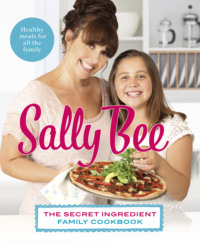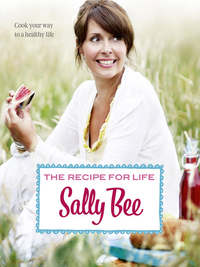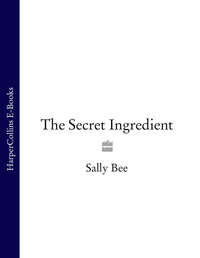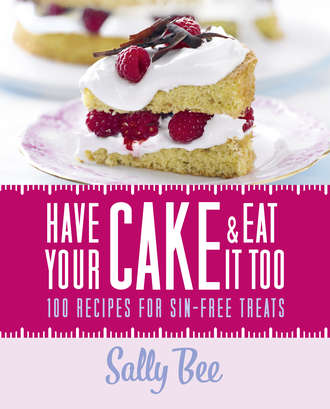
Полная версия
Have Your Cake and Eat it Too


Dedication
This book is dedicated, as ever to my wonderful little family: Dogan, Tarik, Kazim, Lela and Dad!
It is also dedicated to all my heart patients around the country. I know how tough it is to face the day sometimes when you have a worry about your health. We all know that life is too short and healthy eating is crucial to our wellbeing and survival. We also all appreciate how important a special treat and a celebration is. So, this book, filled with goodies, is for you when you need a little pick-me-up to pick you up! Enjoy, my friends, and stay well xx
Contents
Cover
Title Page
Dedication
Introduction
Large Cakes
Pistachio & Yogurt Cake
Angel Food Cake with Lemon Icing
Low-fat Ginger Cake
Fruity Fruit Cake
Mint, Caraway & Lemon Roulade
Courgette Loaf
Butter-free Fudge Cake
Almond & Hazelnut Gateau
Chocolate Cake with Spicy Pears
Beetroot & Chocolate Cake
Fat-free Chocolate Fudge Brownies
Nutty Banana Cake
Low-fat Frosted Carrot Cake
German Honey Cake
Low-fat Date & Walnut Block
Tuscan Grape Cake
Fat-free Strawberry Victoria Sponge
Small Cakes
White Angel Wing Cupcakes
Prune & Oat Muffins
Blueberry Muffins
Almond Macaroons
Banana Chocolate Cupcakes
Spicy Apple Muffins
Breakfast in a Bun
Chocolate Fruity Wraps
Healthy Scones
High Fibre Muffins
Honey & Parsnip Scones
Raspberry Muffins
Gluten-free Chocolate Whoopies
Breads
Courgette & Cranberry Loaf
Oatmeal Fruit Bread
Olive Bread
Soda Bread
Onion Focaccia Bread
Rustic Nutty Spring Onion Loaf
Rye Bread
Sun-dried Tomato Bread
Three-Seed Rolls
Wholemeal Herby Onion Bread
Wholemeal Pitta Bread
Cookies
Ginger Biscuits
Gooey Chocolate Orange Cookies
Chocolate Pistachio Biscuits
Crunchy Nut Fingers
Chocolate-dipped Meringue Fingers
Energy Bites
Gluten-free Cookies
Italian Diamonds
Squishy Flapjacks
Wholemeal Bran Cookies
Cool Puds
Tropical Fruit Pavlova
Banana & Coconut Cream Tart
Caramelised Apples
Breakfast in a Glass
Balsamic Strawberries
Blackcurrant Mousse
Brandy Snap & Berry Tower
Lemon Cream Pudding with Blackberries
Low-fat Baked Lemon Cheesecake
Mint Tea & Raspberry Jellies
Watermelon & Honeydew Jelly
Pineapple, Raspberry & Amaretti Parfaits
Pomegranate & Rhubarb Jelly
Simnel Tart
Strawberry Palmiers
Chocolate Vanilla Mousse
Honey-walnut Turnovers
Hot Desserts
Guilt-free Sticky Toffee Puddings
Tunisian Filo Pastries Stuffed with Dates
Cherry Clafoutis
Apple & Prune Filo Pasty
Caribbean Bananas
Apple Strudel with ‘Cider’ Sauce
Chargrilled Fruit
Peach Upside-down Pudding
Low-fat Hot Bitter Sweet Pudding
Gingerbread Plum Pudding
Glazed Apricot Sponge Pudding
Grilled Peaches with Gingernut Topping
Juicy Berry Cobbler
Healthy Bread & Butter Pudding
Sticky Figs with Pistachios
Light Banana Rice Pudding
Hot Choccy Soufflé
Fruit & Nut Roast
Plum Tarte Tatin
Nearly Summer Pudding
Passionate Pear Crumble
Red Berry Superfood Crumble
Redcurrant & Peach Sponge Delight
Apples in Red Wine
Ices and sorbets
Blackcurrant Bombes
Guava & Agave Lovelies
Classic Lemon Sorbet
Frozen Melon Granita
Ginger, Mango & Orange ‘Zorbit’
Peach & Cardamom Frozen Yogurt
Lemon & Lavender Frozen Yogurt
Peach & Strawberry Sorbet
Raspberry & Coconut Ice Pops
Rocket Lollies
Extras
Frostings
Pomegranate Molasses
Raspberry Coulis
Quick & Easy Low-fat Creamy Custard
Apple Sauce (Butter Replacement)
Acknowledgments
Copyright
About the Publisher
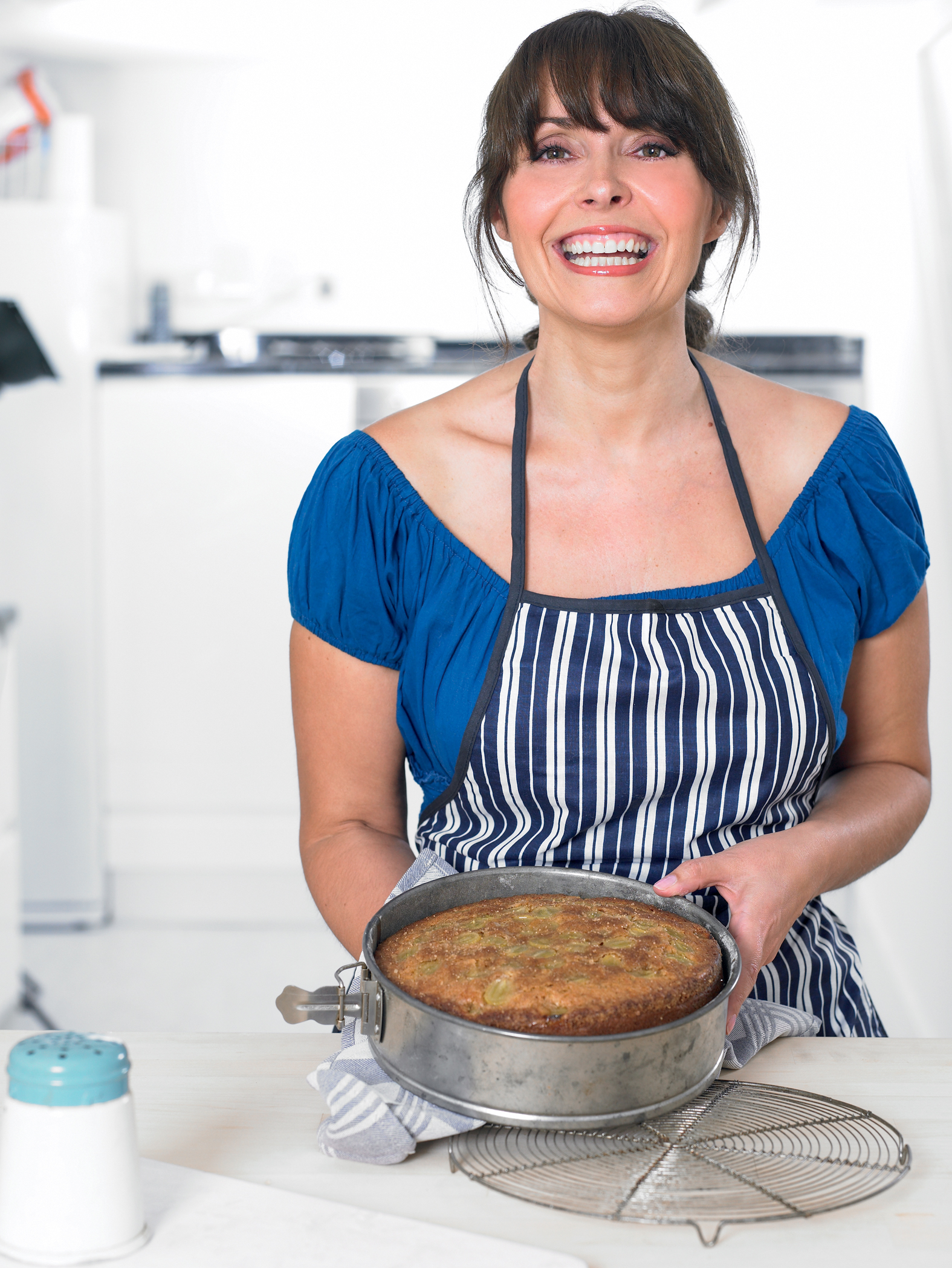
Introduction
Life is too short and time is too precious not to make the most of a heavenly pud! When I thought about writing Have Your Cake And Eat It Too it was a very easy decision to make. You see, although healthy eating for me is a more than a lifestyle choice – it’s actually a life or death choice – I also appreciate how important treats are. Food has to do many jobs for us. It has to satisfy our hunger and it has to give us essential nutrition to help us stay fit, well and strong. But food also needs, sometimes, to support us emotionally. When we are a little low and down in the dumps, a bit of sugar can boost the endorphins and give us a lift. A great meal with friends and family is a treat and shows a kinship; and as food is the glue that holds us all together, finishing a delicious meal off with a heavenly dessert makes us all feel satisfied and worthy of the treat before us.
Having said all that, and keeping in mind our need to stay fit and well, I am always mindful that to enjoy our greatest pleasures guilt-free, sometimes a little tweaking of old favourite recipes is necessary!
In this book I hope I have offered you some perfect, healthier alternatives to some old-fashioned classics and some new ideas to try too. In some of my recipes you will notice that I’ve managed to lose the fat all together; in others I have cut the fat content in half by lessening the quantity or using a low-fat ingredient. In all the recipes, I have followed my general rule of adding as much benefit, nutrition and flavour to my dish as possible. So even though a particular dish may have some fat content, it will be balanced by added nutrition to boost your health. Remember, these aren’t dishes to serve up everyday but they will help you balance your healthy lifestyle and diet with your cravings, desires and that impossible need for a bit of chocolate!
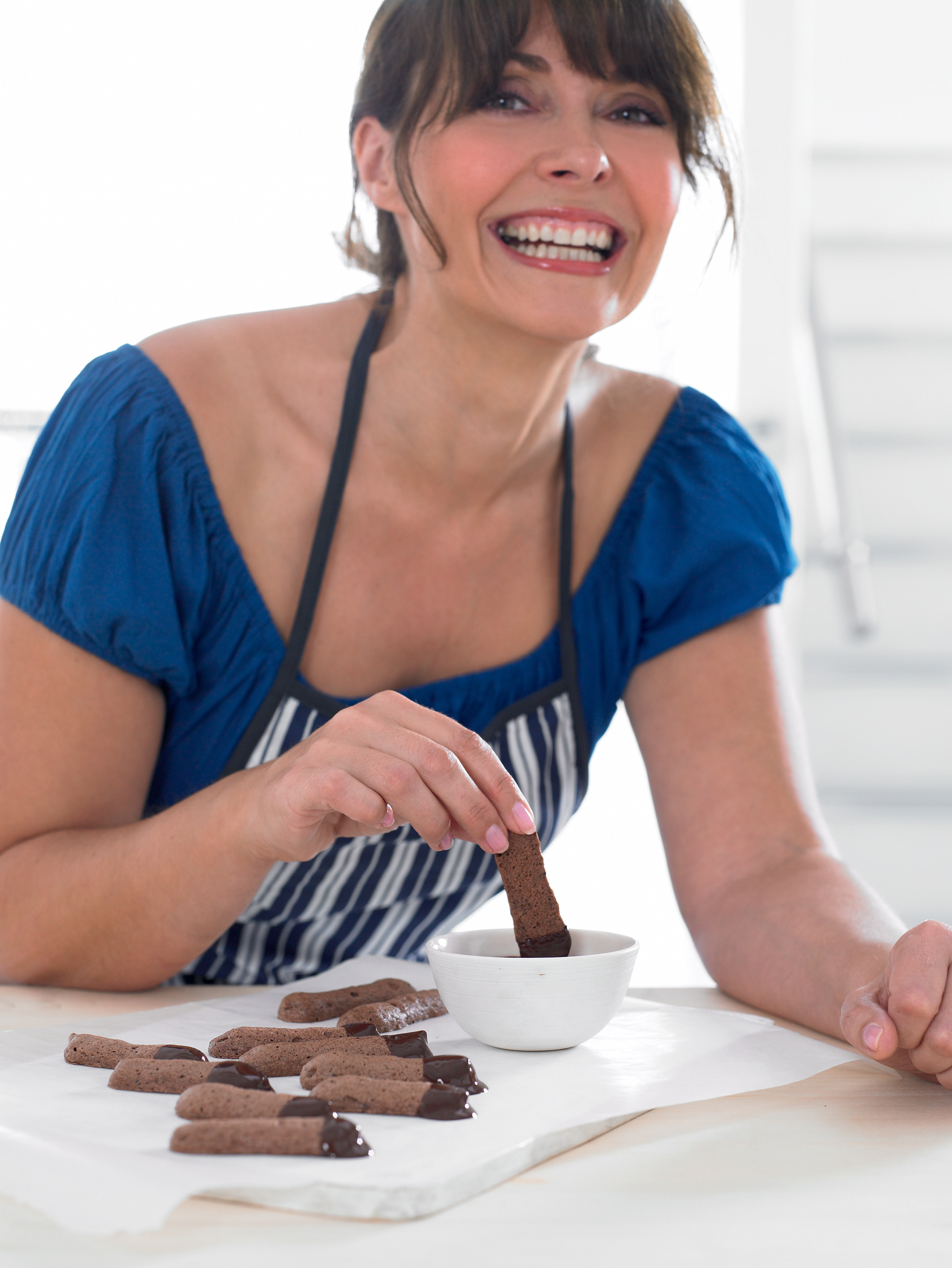
My 10 principles for having your cake and eating it
* I love sweet desserts. You love sweet desserts. Let’s just accept that and enjoy them, but let’s also try to make them as good for us as we can.
* Having established our desire for puddings, let’s still try to stay true to giving our bodies the best nutrition possible. Food is the one thing that gives us health. There are many things that take our health away, like drinking, smoking and a sedentary lifestyle. But food is one of the things which we can control and which can actually make us stay healthy. Although desserts are usually classed as ‘naughty’, we all enjoy a treat once in a while, so we could say that they are good for our soul. Also, many ingredients used in my desserts still offer a good balance of nutritional benefits.
* Sugar is not always the enemy! Although we need to watch the amount of sugar we eat, it is not considered as bad for us as, say, saturated fat. Obviously sugar is high in calories, so we need to watch the quantities we eat, but a little sugar can give us a lift with immediate energy levels. There’s no pretending; it’s a fact that too much sugar is bad for us, but as it’s also something that we crave, I believe that it is better to regulate how we use sugar and in what amounts to ensure healthy sugar levels, healthy weight and a healthy brain function. All my children are lucky to be very active and they all struggle to maintain a healthy weight, therefore, as long as they have had a good-sized nutritional meal with plenty of fresh vegetables, I am very happy for them to enjoy a homemade dessert that will satisfy their cravings and give them the extra vitamins they need from any added fruit.
* Although these are the healthiest possible desserts, they should still be looked upon as a treat! Portion size is very important. It’s no good making a healthier version of a cake if you eat the whole thing in one go! Take note of the portion size guides I have given on each recipe where possible. So even though we are going to accept that a little sugar and fat is fine in a dessert we are not going to eat a huge portion, everyday – are we? If you do get carried away and have a few too many portions, don’t panic – just go for a lovely long walk and give thanks for the energy that delicious dessert has given you!
* A little note on dairy produce. You will notice that many of my dessert recipes either contain some low-fat dairy produce or are served with some. This was a conscious decision on my part, as including some low-fat dairy products into your diet is really important for your general health. Calcium is essential for healthy bones. It is also important for muscle contraction, blood vessel expansion and contraction, secretion of hormones and enzymes, transmitting impulses throughout the nervous system and normal blood clotting. So, it’s pretty important!
* A study into the health benefits of milk and dairy produce commissioned by The British Heart Foundation showed that consuming milk and dairy products can massively reduce the risk of cardiovascular disease. So, while we often focus on the value of dairy foods for healthy bones and teeth in the young and elderly, this study reminds us of the importance of including dairy foods in our diet throughout our life. Dairy products can help our heart health at any age, but it’s important to ensure they are low fat. So often, people following a healthy eating plan concentrate heavily on the fish, chicken fruit and vegetables, and they forget about dairy. And, in the past, heart patients especially have been warned away from dairy foods, but now it seems that common sense and balance prevail and as long as you stick to the low-fat varieties, a little dairy will do you good.
* 1 egg is an oeuf! Or is it? Contrary to common belief, your body does not absorb cholesterol from eggs. If you are on a low cholesterol diet, eggs are not a problem in this respect. Eggs do contain up to 5 grams of fat in the yolk, so this certainly has to be considered, but as far as cholesterol is concerned, eggs are not the enemy. Nutrition scientists have found that eggs are one of the most nutrient-dense foods available and are recommending that we eat at least one egg a day to get the optimum benefits. In the study, to be published in the journal ‘Nutrition and Food Science’, researchers discovered that eggs can play an important role in maintaining health as well as help with weight loss and dieting. The study discovered that, despite being low in calories, eggs are a rich source of protein and are packed with essential nutrients thought vital to good health, particularly vitamin D, vitamin B12 and selenium. The report also confirms that among protein foods, eggs contain the richest mix of essential amino acids, which is crucial for children, adolescents and young adults since a balance of amino acids is required for proper growth and repair. So, that proves that an egg a day keeps the doctor away!
* Fruit, fruit and more fruit. Fresh fruit is the best starting point for any dessert because of its generally sweet flavour, juicy nature, bright colour and nutritional content. So, even if you are making a dish that doesn’t contain fruit, serve a side portion of fresh fruit with it to make sure you’re making the most of your treat!
* Make substitutions! If you have a favourite family recipe, try to make some substitutions to make it more healthy. If you have a dessert recipe that contains butter, one of the first things you can do is use a low-fat, heart-healthy spread instead. There are wonderful heart-healthy products available that are suitable for baking, give great results and contain only half the saturated fat of butter. It is also sometimes possible to substitute the fat in cakes for another ‘wet’ ingredient, such as apple sauce or prune purée. This will be a trial-and-error scenario for you, but do be brave and give it a go: with just a little tweaking here and there, you can produce an old favourite with half the fat. And if you come up with a really great recipe, send it to me!
* Try cutting the sugar content in a recipe in half as this often works and will just cut down on the sweetness – obviously! Or you can swap the sugar for one of the sugar substitute products on the market. I actually prefer to keep my recipes as natural as possible, so I don’t use artificial sweeteners.
Why all the fruit?
Good nutrition is key to living a long and healthy life. Increasingly we are receiving poor nutrition from ready-meals, fast food and processed foods. These foods contain little, or no nutritional value, and are usually loaded with salt, hydrogenated fats and sugar. Poor nutrition can lead to various health problems in the short and long term, and make you feel tired, lethargic, and miserable too.
Nutritional Value of Fruit
Fruit is so nutritious, that we can almost live off it. A diet that is packed with plenty of fruit and nuts will be rich in protein, calcium and vitamins, which is essential for a healthy lifestyle.
Most fruit is naturally low in fat, sodium, and calories. What’s more, they don’t contain cholesterol, but are packed full of vitamins and minerals – the right nutrients your body needs. These nutrients include potassium, dietary fibre, vitamin C and folate (folic acid).
Potassium
Diets rich in potassium will contribute to a healthy blood pressure and a reduced risk of developing kidney stones. Fruits that contain potassium include bananas, plums, prunes, peaches, apricots and oranges.
Dietary Fibre
Regular amounts of dietary fibre help reduce blood cholesterol levels and may lower the risk of heart disease. It is also important in maintaining regular bowel movements. Fibre helps reduce constipation and therefore reduce the amount of toxins exposed to the bowel for any length of time. All fruits contain dietary fibre, but fruit juice doesn’t, so you will need to eat the whole fruit to get this nutritional benefit.
Vitamin C
Vitamin C is essential for the growth and repair of body tissues. It helps heal cuts and wounds, and keeps teeth and gums healthy. It is also a powerful antioxidant that neutralises free radicals in the body. Fruits that contain vitamin C include oranges, mangoes, apples and grapes.
Folate (folic acid)
Folate helps the body form red blood cells. It is especially important for pregnant women, as folate has been proven to help prevent foetal defects from developing, such as spina bifida. Fruits that contain folate include oranges, bananas and kiwi fruit.
Antioxidants in fruit
Free radicals and antioxidants are both terms used to describe groups of vitamins, minerals and elements that help to gather up and destroy all the bad bugs and boost growth of the good bugs. Therefore when a fruit is considered high in free radicals or antioxidants, this means that it will help protect your immune system, guard against certain cancers and help boost your general good health.
Protein from Fruit
The body makes proteins to create muscles, tendons, ligaments, hair and nails. Proteins are also important in the make-up of enzymes, genes and hormones. Fruits that contain protein include: dates, avocados, figs, peanuts, almonds, Brazil nuts, and walnuts.
Fats from Fruit
Most of the fat in the Western diet is bad fat – saturated and hydrogenated fats – that increases our risk of developing heart disease and cancers. Some fat is good fat, however, and these fats contain essential fatty acids (which are the fats that are needed to help our body function rather than the type of fat that acts as a fuel which we burn for energy) and vitamins that help our bodies stay healthy. Fat improves the body’s absorption of vitamins A, D and E. Fruits that contain essential fatty acids include olives, avocados, and nuts and seeds. It’s also important to note that all my recipes use a low-saturated-fat, heart-healthy spread instead of butter.
So, although most people will find a diet that consists exclusively of fruit and nuts a little extreme, it shows that they contain much of what we need to live a healthy, happy life. Fruits are packed full of vitamins, minerals, essential fatty acids and proteins, and don’t contain all the bad nutrition that can contribute to obesity, diabetes, Alzheimer’s, and cancer. So why not take a look at your eating habits over the space of a week and add the odd healthy dessert along with extra fruit. It won’t just make you feel better; it could save your life.
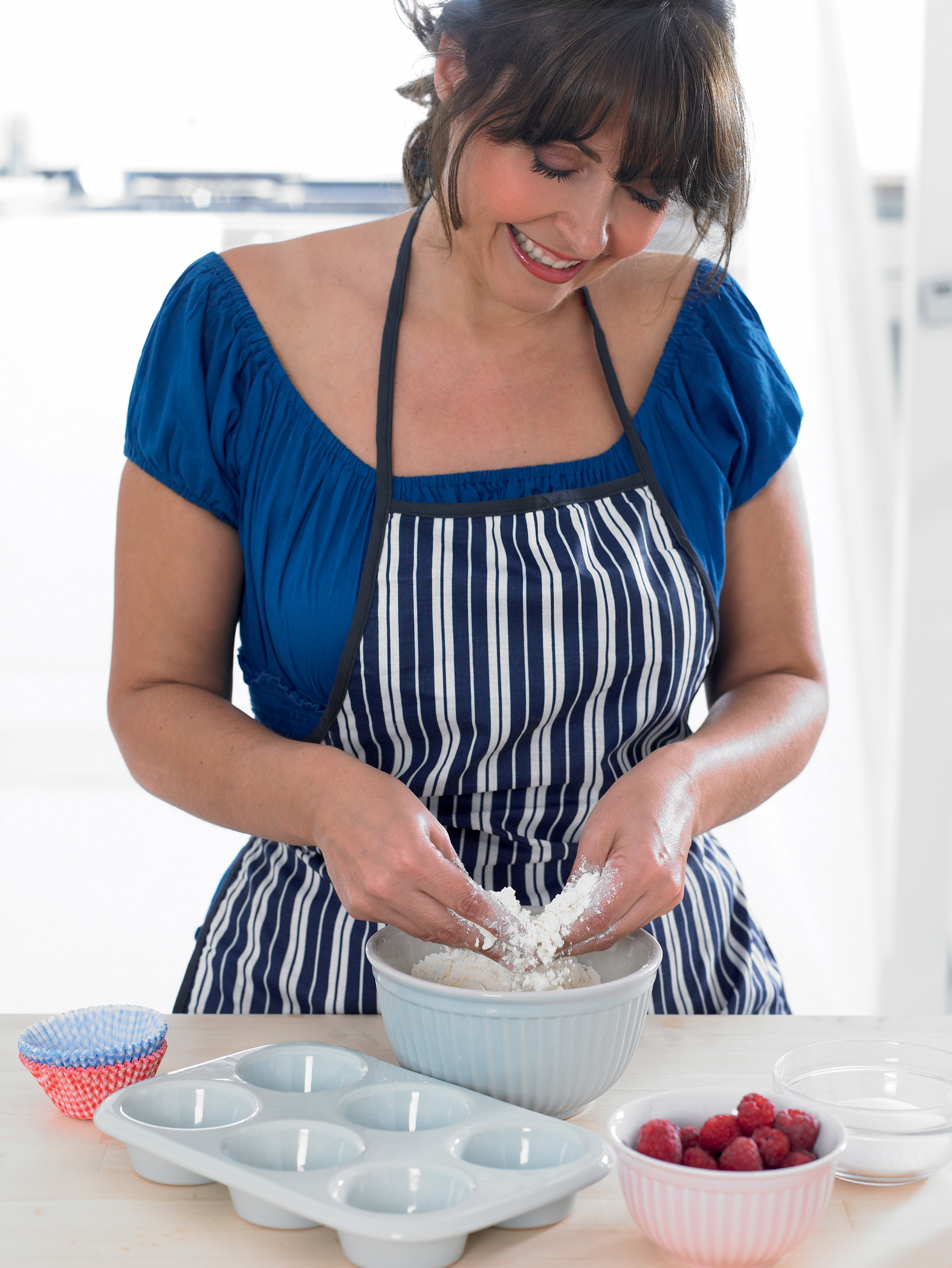

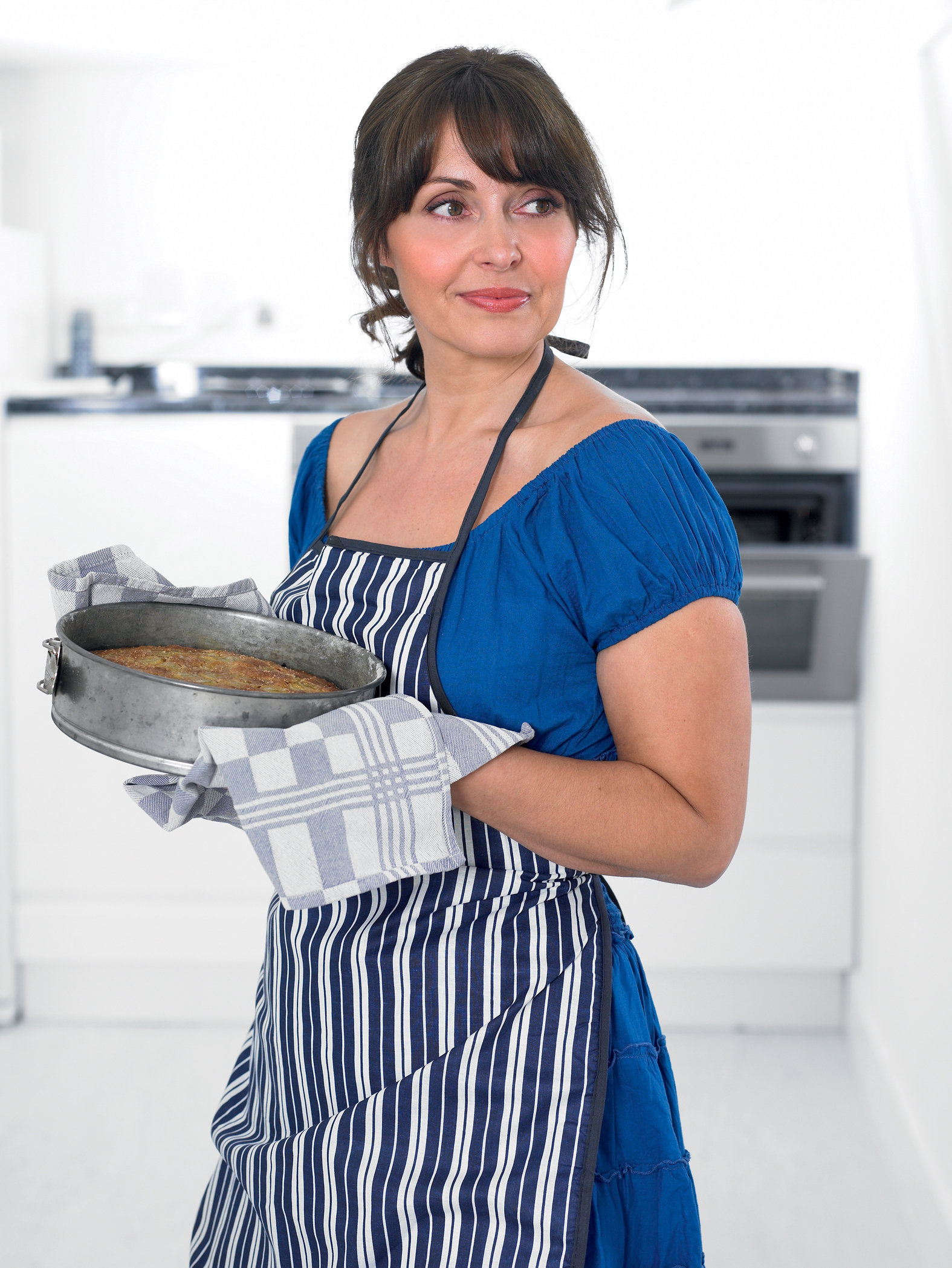
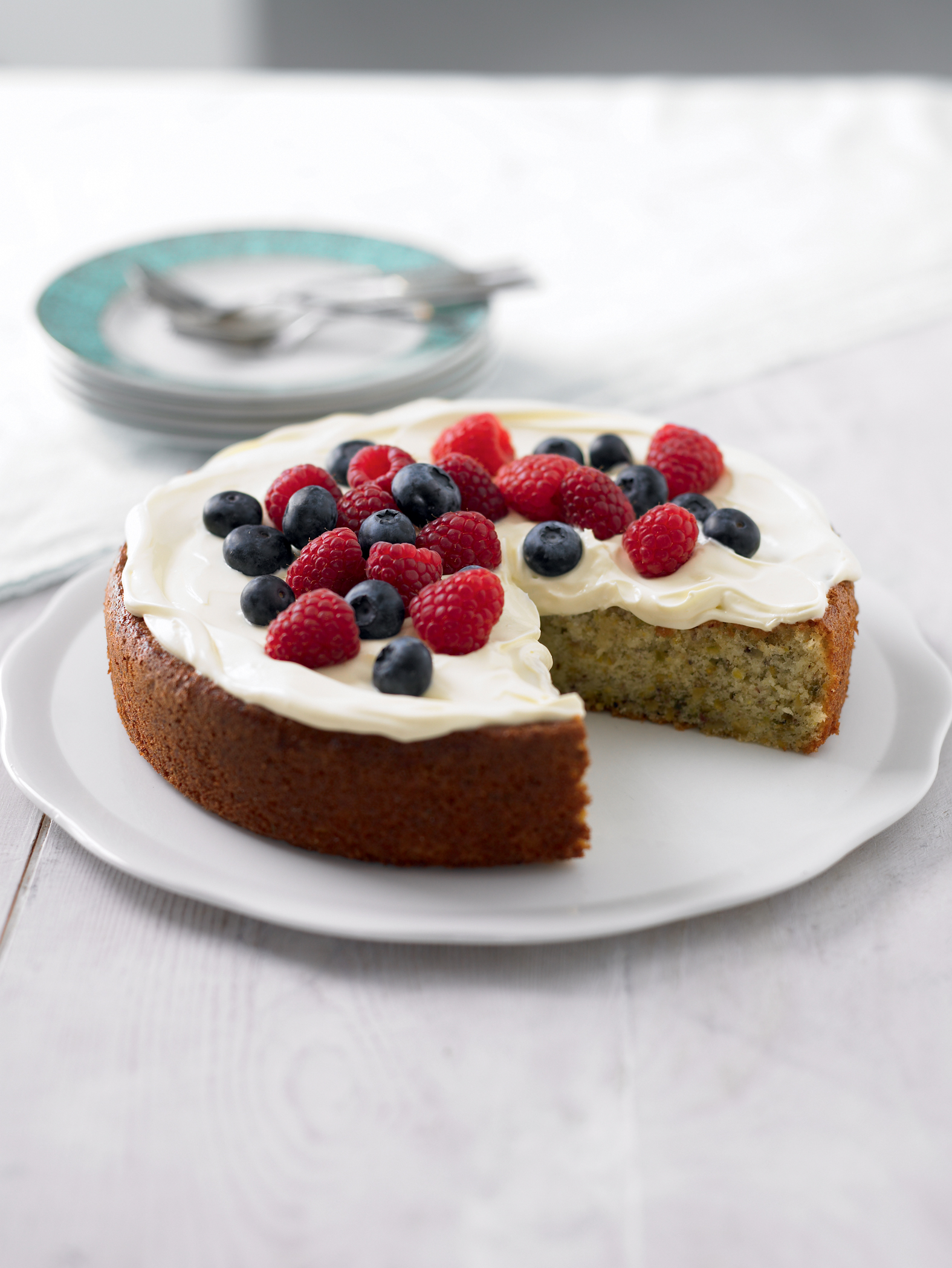
Pistachio & Yogurt Cake
This fabulous recipe uses light olive oil and low-fat yogurt instead of butter, so keeping the fat content healthy and low. Very simple to make, this cake is beautiful served with a side order of fruit and a dollop or topping of low-fat crème fraîche or Greek yogurt.
SERVES 10
light olive oil or low-fat spread, for oiling or greasing
140g (5oz) shelled, unsalted pistachio nuts
4 eggs
175g (6oz) caster sugar
150g (5½oz) plain low- fat yogurt
75ml (3fl oz) light olive oil
115g (4oz) self-raising flour
1 Preheat the oven to 160°C/315°F/Gas mark 2–3.
2 Oil a 23cm (9in) springform cake tin with a little light olive oil or use some low-fat spread.
3 Start by finely grinding the pistachios in a food processor, then set aside.
4 Using a free-standing electric mixer, beat the eggs and the sugar together until very pale and thick. This will take about 5 minutes, so be patient with it!
5 Next, gently mix in the yogurt and olive oil.
6 Now, sift in the flour and fold in using a spatula, then add the ground pistachios.
7 Pour the mixture into the prepared tin and bake for 40 minutes or until a skewer inserted into the centre of the cake comes out clean. Allow to cool in the tin for 10 minutes, then turn out onto a wire rack to cool.
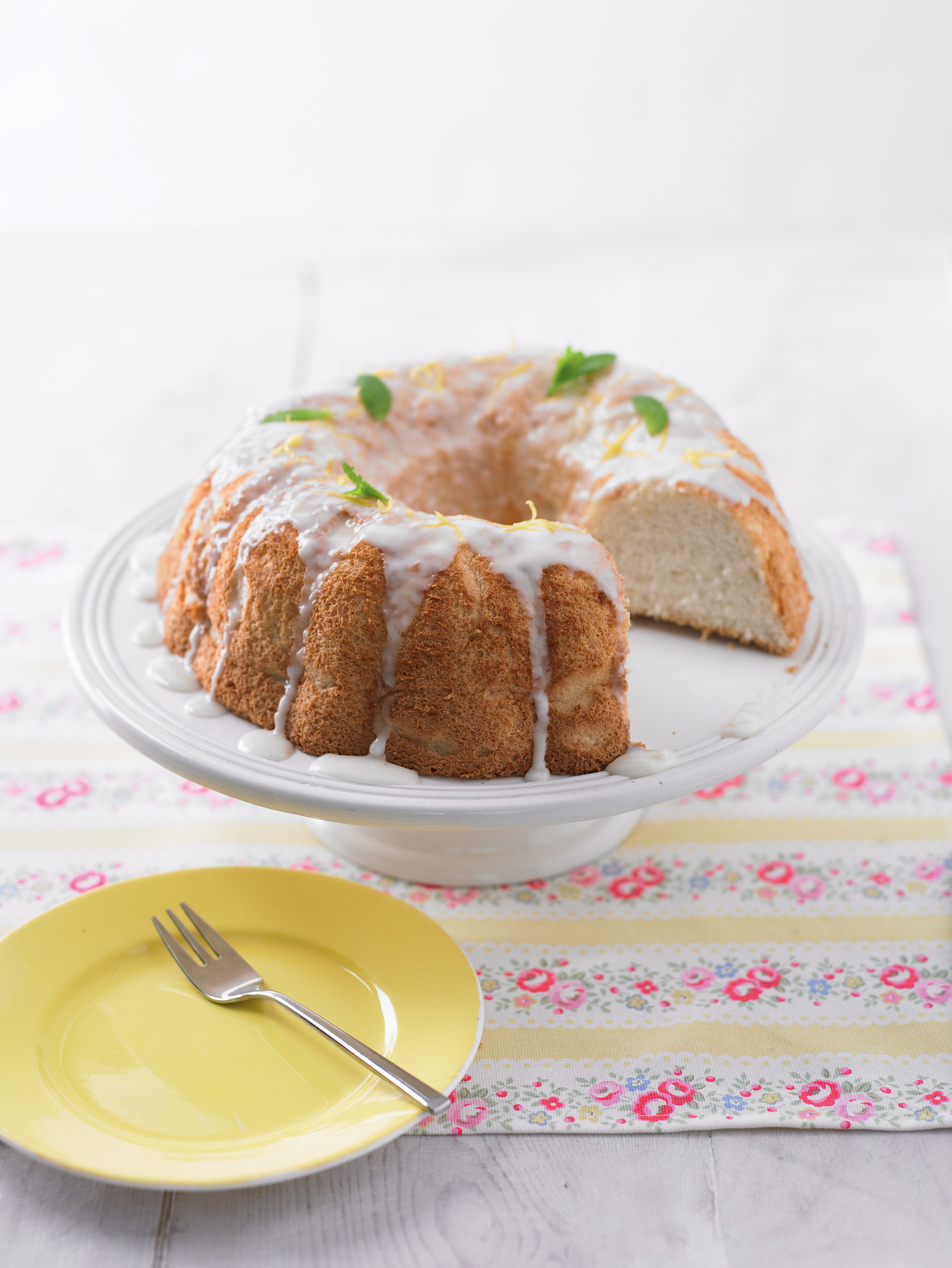
Angel Food Cake with Lemon Icing
A fat-free cake that looks seriously impressive! Serve on the day it is made with lots of sweet and colourful fruit. This recipe makes one large cake, so it is ideal for when you have a house full of guests. You will need a 25cm (10in) non-stick Bundt tin for this cake, which is available from good kitchen shops.
SERVES 12-16
12 egg whites
1¼ tsp cream of tartar
½ tsp lemon juice
grated zest of 1 unwaxed lemon
1 tsp vanilla extract
190g (6¾oz) icing sugar
135g (4¾oz) plain flour
For the icing
juice of ½ lemon
3 tbsp clear, runny honey
8 tbsp icing sugar
To decorate
grated lemon zest
fresh mint sprigs
1 Preheat the oven to 180°C/350°F/Gas mark 4.
2 Using a free-standing electric mixer, whisk the egg whites and cream of tartar together until the mixture is frothy but not too stiff.
3 Next, add the lemon juice, grated lemon zest and vanilla extract, and continue to whisk while adding the icing sugar, a bit at a time. Carry on until stiff peaks form and the egg whites are nicely glossy.
4 Now, the flour needs to be sifted and added to the egg white mixture. Try to add a little height while sifting the flour over the mixture, as this will make your cake lighter. Use a spatula or large metal spoon to carefully and quickly fold in the flour until incorporated. Do not beat or overmix. Limit yourself to 16 turns of the spoon!
5 Pour the mixture into a 25cm (10in) non-stick Bundt cake tin and bake for 30–40 minutes until the top is brown and a skewer inserted halfway between the inner and outer wall of the tin comes out clean.
6 Don’t turn the cake out, simply turn the tin upside down on top of a wire rack and leave the cake to cool inside the tin for about an hour.
7 Now, carefully use a plastic spatula to loosen the cake around the sides and middle, then release the cake and place on a serving plate.
8 For the icing, simply mix the lemon juice, honey and icing sugar together and pour over the cake just before serving. Decorate with lemon zest and mint sprigs.
Low-fat Ginger Cake
If it’s holiday time, make this to fill your house with festive smells. If it’s not holiday time, make it anyway! This cake is easy to make, delicious and low in fat – enjoy a delicious piece of this ginger cake guilt-free any time.
SERVES 9
light cooking spray, for coating
200g (7oz) dark muscovado sugar
1 egg
60ml (2fl oz) light olive oil
125ml (4fl oz) low-fat buttermilk
200g (7oz) plain flour
1 tsp ground ginger
1 tsp ground cinnamon
½ tsp baking powder
1 Preheat the oven to 180°C/350°F/Gas mark 4.
2 Spray a 20cm (8in) square cake tin with light cooking spray and line the base with baking parchment.
3 In a large bowl, mix the sugar, egg and olive oil together until smooth. Now, add the buttermilk and combine well.
4 Next, sift the flour, ground ginger, cinnamon and baking powder into the wet ingredients and mix with a wooden spoon. Don’t overmix.
5 Pour the mixture into the prepared tin and bake for 25–30 minutes or until a skewer inserted into the centre of the cake comes out clean. Allow to cool in the tin for 5 minutes, then turn out onto a wire rack to cool. Once cold, cut into squares to serve.
TIP
Feel free to dust the top of the cake with a little mixture of icing sugar and cocoa powder.




